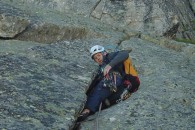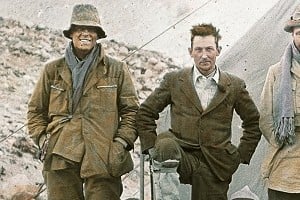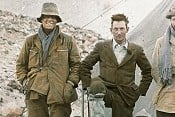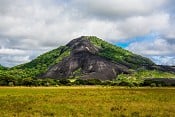
An article and film by James Mann about Pat Littlejohn and Peter Biven's audacious first ascent of Moonraker on The Old Redoubt. A journey back through time to August 1967 when the crag was still unknown territory. The climbing life of a young Littlejohn comes full circle as he climbs the route exactly fifty years to the hour later, with Peter's granddaughter. Anna Biven experiences her first time on a sea-cliff as she follows in her incredible grandfather's footsteps.
'Even to the most hardened eye it is an imposing place; a big impending wall with the sea battering along its base out to a ragged headland, and the vast mouth of a cave opening on its right'. Al Alvarez' description of The Old Redoubt from his essay about Moonraker (HVS 5a) in Hard Rock paints a vivid picture. He doesn't oversell the place. Its presence is keenly felt by any climber as they walk from the car, over the flat, grassy plain of Berry Head and down through the gate and the steep slope leading to the gearing up spot. From here the crag remains hidden, guarded by the clamber down into the Great Cave. Alvarez' brilliant essay skilfully manoeuvres the reader down to the cave platform, along the traverse and upwards, ever upwards towards the top corner crack and a final shuddering heave into a crowd of disbelieving holiday-makers.
It was this piece of writing and John Cleare's incredible photographs of the route that made Moonraker a modern sea-cliff classic and a rite of passage for climbers living in or visiting the south west. Of the first ascent, I was somewhat ignorant. I knew that Pat had been young when it was done and that Pete Biven had taken all kinds of visitors to his household up it in the years following the first ascent; a proud parent indeed!
Peter Biven, in partnership with Trevor Peck and his brother Barrie, had made great leaps during flying visits to West Penwith during the fifties, leaving classic routes like Doorpost, Suicide Wall and Anvil Chorus as coveted ticks for future visitors. By the mid sixties he was living in the West Country and climbing most regularly in Devon with various members of the Exeter Climbing Club. He clearly had great influence upon the Devon scene.

John Cleare on his great friend, 'Pete, then 32, was a rock climber of vast experience, already known for his exploits on gritstone before Pat was born. Now a laid-back academic and the catalyst of climbing in the West Country, Pete was proud to demonstrate the delights of Torbay limestone to climbers visiting from elsewhere, and was naturally the presiding genius of the burgeoning group of climbers in the Exeter area to which Pat now belonged'.

Pat's thoughts on Pete: 'He helped to hold the ideas and attitudes of many promising climbers in the Exeter area by the force of his own personality. His approach to climbing was the antithesis of the arid, gymnastic activity it has become for some people. At the core of his approach to climbing was a thirst for adventure, and the greater the variety of demands a climbing day made on his skill, ingenuity and courage, the more he enjoyed it. He particularly enjoyed sea cliffs and was a master of coastal traversing'.
His death in a climbing accident in 1976 sent shock waves through the south west climbing community and beyond.
I was lucky enough last Easter to have the opportunity to interview Pat. We sat down and talked early days. On the subject of Moonraker, I sat transfixed as Pat jumped back in time to his school holidays of 1967 and recalled the excitement of the route, the influence upon him of members of the Exeter Climbing Club and his feelings about Pete. At the end of this, Pat mentioned that he was really keen to climb Moonraker again on the fifth of August; the fiftieth. A discussion about a possible film project ensued. Communications passed from South Devon to North Wales and back, reconnaissance undertaken, forecasts checked, friends press-ganged and a variety of climbing and camera equipment packed.
This, then is how the Biven/Littlejohn partnership was rekindled on August fifth, 2017; not Peter Biven with a young Pat, but a much younger Biven; Anna; climbing with a somewhat more experienced, but still youthfully enthusiastic Littlejohn.
Conditions were perfect. The cliffs weren't beaten by the sea this day, but lapped at softly and gently; respectful, inviting and welcoming of a meeting with an old friend to reminisce on stories half remembered and kindly ghosts of old friends. For Anna, an opportunity to stand close to her grandfather, to follow in his favourite footsteps.

The film tells Moonraker's story and hopefully gives a little insight into the world of a young Littlejohn. The climbing footage was shot in a single take with as little interference as possible from the camera team into the private world of Pat and Anna.
Anna's take on Moonraker:
Moonraker had always been the one climb of my grandfather's that I always wanted to do, so when I found out I had the opportunity to climb the route with Pat on its 50th anniversary I was overjoyed.
I immediately agreed to do the climb and it wasn't until the summer approached I realised that a multi-pitch sea cliff was a serious undertaking for someone of my limited experience. On the day I had a chance to talk to Pat during the journey to Berry Head and prepare myself for the climb. By the time we had reached the car park I was feeling fairly nonchalant about the whole affair. This feeling dissolved when we reached the grassy slope adjacent to the cave and I was confronted by not only the gaping maw of the Old Redoubt and the climb itself, but also the rather dubious looking gear we would be using to scale it.
When we began the descent into the cave, I began questioning why I had been allowed to do this and whether it might just be easier to have a cup of tea in the cafe. The traverse was a challenge as seaweed and barnacles had been something I'd rarely had to contend with; this was only made worse by the silhouette of Pat a metre or so ahead making his way along with an impossible ease. By the time we reached the foot of the climb I was so nervous I nearly dropped my belay device in the sea.
Between the traverse, hanging belays and vomiting seabirds, all of which I'd never had to contend with, the climb was comparatively easy. It was only when doing the route did I realise why it was considered such a classic, and why my grandfather had devoted so much time and energy making it the climb it is today. Not only is the rock itself beautiful but it flows in a way that makes it feel pleasing to climb, combined with the stunning coastline and it comes together to be an enjoyable venture. It was a joy to climb with Pat and to hear about my grandfather from the viewpoint of a rope-mate who knew and admired him. In doing this climb I feel like I learned a bit more about who my grandfather was and the climbing scene of the '60s.
The historical photographs came from a variety of sources. A chance meeting with John Cleare revealed that he had all sorts of images from just after the time of the first ascent.
Pat recalls, 'John Cleare was always taking brilliant pictures and he was quite inspired by the crag. John and Pete had been friends for quite a long time and had often climbed together in Cornwall. He had taken pictures of Pete at Bosigran main face and Great Zawn and was very much involved in the South-West scene. His primary aim was to take photographs but he would also always be keen to climb'.

Pat and Frank Cannings contributed images from their archive and Nick Biven had a hunt through some of his father's belongings, which as well as a collection of prints, Pete Biven's notes on nesting restrictions and a proof of Alvarez' Hard Rock essay, contained a carefully looked after Agfa negative holder. This time capsule held some of Peter Biven's photographs of both Moonraker and other climbs in and around Torbay with Frank Cannings, Pat, Steve Jones, John Fowler and other members of the Exeter Climbing Club.
The music used in the film has significance. Sibelius was one of Pete's most loved composers and the Finlandia Suite a true favourite. Pat and Frank talk of owing their love of classical music to Pete. Interestingly, Pete's love of Bob Dylan can be attributed to one Frank Cannings!
As far climbing on The Old Redoubt is concerned, Moonraker was only the beginning. On returning from the Alps, Frank Cannings accompanied Pete on what was to be a repeat ascent of Moonraker. Frank, whose climbing was clearly shifting into an altogether different gear at this time, looked up at the wall above the cave and in attempting what was later to become Dreadnought, added Barbican on his first visit to the cliff. It was to be two years before his conceived line would be completed, when he made the magnificent and somewhat epic first ascent of Dreadnought alongside Pat. Other major lines of 1969 such as The Seventh Circle and The Hood are clear reminders of the ability of both Cannings and Littlejohn's ability to tackle difficult climbing in serious situations.

I have enjoyed working on this immensely. It is important that the images and stories of British climbing are preserved and not just lost to the march of time. To look over our shoulders at the deeds and characters of the past is to understand the direction of climbing's future.

'We will all miss the fast drives to the sea in some wreck of a car being blitzed by Beethoven and Brahms. We will miss the security of the Biven barometer. Whenever his right hand waggled by his side, as if rejigging some power to his fingertips, we knew we had better look sharp'. Barrie Biven - Climber's Club Journal 1976
I must thank my collaborators in this project: John Cleare for his incredible images, advice and generosity, Anna Biven for her cool head on the day and writing that appears here, Frank Cannings for his extraordinary memory of people and places as well as his photographic collection and Adrian Parsons, Pete Saunders and Brian Hannon for their massive help on the day of filming. Lastly to Pat for conceiving this project and for his enthusiasm, kindness and support. We've got the seventies to get to yet!
Watch the film commemorating the first ascent below:


























Comments